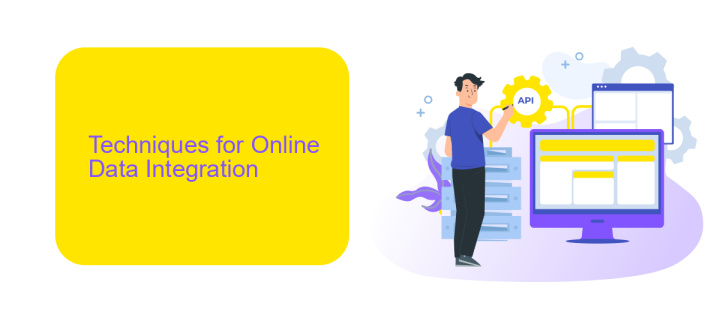Online Data Integration
Online data integration is a crucial process in today's digital landscape, enabling seamless connectivity and real-time data exchange between disparate systems. By integrating data from various sources, businesses can enhance decision-making, improve operational efficiency, and gain a comprehensive view of their operations. This article explores the key benefits, challenges, and best practices for implementing effective online data integration strategies.
Introduction
Online data integration has become a critical component for businesses aiming to streamline operations and make data-driven decisions. This process involves combining data from various sources into a single, unified view, enabling more efficient analysis and reporting. As organizations increasingly rely on multiple software applications, the need for seamless data integration has never been more apparent.
- Improved data accuracy and consistency
- Enhanced decision-making capabilities
- Increased operational efficiency
- Reduction in manual data entry and errors
Tools like ApiX-Drive facilitate online data integration by providing a user-friendly platform for connecting various applications and automating data workflows. By leveraging such services, businesses can effortlessly synchronize their data, ensuring that information is always up-to-date and accessible. This not only saves time but also empowers organizations to focus on strategic initiatives rather than getting bogged down by technical complexities.
Techniques for Online Data Integration

Online data integration involves various techniques to seamlessly connect and synchronize data from disparate sources. One common approach is using APIs (Application Programming Interfaces) to enable real-time communication between different systems. APIs facilitate the exchange of data by providing a standardized way for applications to interact. Another technique is ETL (Extract, Transform, Load), which involves extracting data from multiple sources, transforming it into a consistent format, and loading it into a target system. This method ensures data consistency and quality across platforms.
Automation tools like ApiX-Drive can significantly simplify the integration process. ApiX-Drive allows users to connect various applications and services without extensive coding knowledge. It supports a wide range of integrations, enabling automated data transfer and synchronization between systems. By using such tools, businesses can reduce manual data handling, minimize errors, and ensure that data is always up-to-date. These techniques collectively enhance the efficiency and reliability of online data integration, making it easier for organizations to manage and utilize their data effectively.
Challenges and Considerations

Online data integration presents several challenges and considerations that organizations must address to ensure seamless and efficient operations. The complexity of integrating diverse data sources, maintaining data quality, and ensuring real-time data synchronization are just a few of the hurdles that need to be overcome.
- Data Quality and Consistency: Ensuring that data from various sources is accurate, up-to-date, and consistent is a significant challenge. Poor data quality can lead to incorrect insights and decisions.
- Security and Privacy: Protecting sensitive information during data transfer and integration is crucial. Implementing robust security measures to safeguard data from breaches is essential.
- Scalability: As data volumes grow, the integration solution must scale efficiently to handle increased loads without compromising performance.
- Interoperability: Different systems and applications often use varied data formats and protocols, making interoperability a key consideration.
To address these challenges, organizations can leverage tools like ApiX-Drive, which simplifies the integration process by providing a user-friendly platform for connecting various applications and automating data workflows. By utilizing such services, businesses can enhance their data integration efforts, ensuring smoother operations and better decision-making capabilities.
Applications and Use Cases

Online data integration is essential for modern businesses to streamline operations and enhance decision-making processes. By consolidating data from various sources into a unified system, organizations can achieve greater efficiency and accuracy in their workflows.
One of the primary applications of online data integration is in customer relationship management (CRM). By integrating data from different platforms, businesses can gain a comprehensive view of their customers, enabling personalized marketing strategies and improved customer service.
- Real-time data synchronization across multiple platforms
- Automated data transfer and processing
- Enhanced data accuracy and consistency
- Improved decision-making through consolidated insights
Services like ApiX-Drive facilitate the setup of seamless data integrations without requiring extensive technical expertise. By automating the data flow between various applications, ApiX-Drive helps businesses save time and resources, allowing them to focus on core activities. This makes online data integration accessible and beneficial for companies of all sizes.
Future Directions and Research
As online data integration continues to evolve, future research should focus on enhancing the interoperability and scalability of integration platforms. Emphasis on machine learning algorithms to automate data mapping and transformation processes will be crucial. Additionally, the integration of real-time data processing capabilities and advanced analytics will enable more dynamic and responsive systems, providing businesses with the agility needed to adapt to rapidly changing environments.
Exploring the potential of services like ApiX-Drive can offer valuable insights into simplifying the integration setup process. By providing user-friendly interfaces and pre-configured connectors, such platforms can significantly reduce the complexity and time required for integration. Future research should also investigate security measures to protect data integrity and privacy in integrated systems, ensuring robust and secure data exchange across various platforms.
FAQ
What is online data integration?
Why is online data integration important for businesses?
What are the common challenges in online data integration?
How can businesses automate their online data integration processes?
What should businesses consider when choosing an online data integration tool?
Apix-Drive is a simple and efficient system connector that will help you automate routine tasks and optimize business processes. You can save time and money, direct these resources to more important purposes. Test ApiX-Drive and make sure that this tool will relieve your employees and after 5 minutes of settings your business will start working faster.

